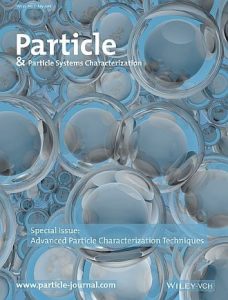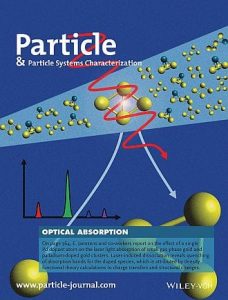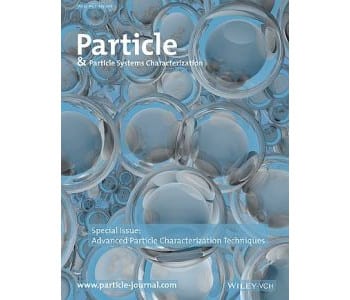By Luis Liz-Marzán and Sara Bals
 Nanoparticles play a key role in modern technology because of their unique physical and chemical properties, which are often very sensitive to the specific structure of each nanosystem. Typical examples are quantum dots or metal nanoparticles, which display unusual optoelectronic properties that can be tailored by changing their size and shape. Catalytic processes can also be exquisitely selective towards specific crystallographic facets or even atomic sites. Although less obvious, there is also a close connection between the activity of proteins and other biomolecules and their nanoscale structure. Understanding the connection between the physicochemical properties and the local structure or composition of nanomaterials is therefore of crucial importance, not only toward the design of nanostructures with desired functionalities and the incorporation of such structures in actual nanodevices, but also toward further understanding of the way living systems function and in turn devising diagnostic and therapeutic tools. Gaining such insights is far from straightforward especially since the complexity of nanosystems has increased significantly over the past years. Such new developments in the field of nanotechnology drive the need for more advanced quantitative characterization techniques, for both measuring structure and properties, which can be applied to more complex nanostructures and to even actual nanodevices.
Nanoparticles play a key role in modern technology because of their unique physical and chemical properties, which are often very sensitive to the specific structure of each nanosystem. Typical examples are quantum dots or metal nanoparticles, which display unusual optoelectronic properties that can be tailored by changing their size and shape. Catalytic processes can also be exquisitely selective towards specific crystallographic facets or even atomic sites. Although less obvious, there is also a close connection between the activity of proteins and other biomolecules and their nanoscale structure. Understanding the connection between the physicochemical properties and the local structure or composition of nanomaterials is therefore of crucial importance, not only toward the design of nanostructures with desired functionalities and the incorporation of such structures in actual nanodevices, but also toward further understanding of the way living systems function and in turn devising diagnostic and therapeutic tools. Gaining such insights is far from straightforward especially since the complexity of nanosystems has increased significantly over the past years. Such new developments in the field of nanotechnology drive the need for more advanced quantitative characterization techniques, for both measuring structure and properties, which can be applied to more complex nanostructures and to even actual nanodevices.
Given the rapid and exciting evolution of the field, we saw the need for putting together a special issue specifically dedicated to “Advanced Particle Characterization Techniques”. The issue was conceived as a collection of selected contributions by different researchers who are recognized as experts in the field of structural characterization as well as on optical and catalytic properties of nanoparticles. While we have not intended to be exhaustive, and the choice has been biased by our own interest, obviously not all of the leading groups are represented by any means, but the final collection of papers definitely provides an excellent overview of current research directions. We would like to express our gratitude to all contributors for their effort and support toward this initiative. In what follows, a brief description of the papers included in this issue is provided, which intends to serve as an introduction to encourage further reading.
Several contributions are related to the application of electron microscopy to investigate the structure, composition and properties of nanoparticles and clusters. An integrated optical-electron microscope was used by Debroye et al. (Doi: 10.1002/ppsc.201600037, page 412) as an innovative approach that enables the in situ study of dynamic processes of photo-active materials. In this manner, optically induced processes in ZnO nanoparticles can be unraveled. Chinchilla et al. (Doi: 10.1002/ppsc.201600057, page 419) used transmission electron microscopy (TEM) in combination with X-ray diffraction and X-ray photoelectron spectroscopy (XPS) to correlate the structural properties of Au-Ru bimetallic nanoparticles with their catalytic behavior. This study also demonstrates the need to rely on the simultaneous use of complementary macroscopic and microscopic techniques to accurately reveal the complex structure of this type of system. In the paper by Varambhia et al. (Doi: 10.1002/ppsc.201600067, page 438) annular dark field scanning TEM was combined with advanced quantification and simulation techniques in order to model the 3 dimensional (3D) structure of ultra-small Ru clusters conclusively demonstrating the formation of rafts, which is of great importa nce towards understanding their catalytic performance. Indeed, 3D imaging by TEM has evolved over the last decade into an increasingly important tool to characterize nanoparticles. Electron tomography is well represented in different studies featured in this issue. For example, Meledina et al. (Doi: 10.1002/ppsc.201500252, page 382) used electron tomography to locate Pt nanoclusters inside MIL-101 giant-pore metal-organic frameworks. In addition to structural information, electron tomography can nowadays also be used to retrieve chemical information in 3D, even in a quantitative manner, as demonstrated in the paper by Zanaga et al. (Doi: 10.1002/ppsc.201600021, page 396).
nce towards understanding their catalytic performance. Indeed, 3D imaging by TEM has evolved over the last decade into an increasingly important tool to characterize nanoparticles. Electron tomography is well represented in different studies featured in this issue. For example, Meledina et al. (Doi: 10.1002/ppsc.201500252, page 382) used electron tomography to locate Pt nanoclusters inside MIL-101 giant-pore metal-organic frameworks. In addition to structural information, electron tomography can nowadays also be used to retrieve chemical information in 3D, even in a quantitative manner, as demonstrated in the paper by Zanaga et al. (Doi: 10.1002/ppsc.201600021, page 396).
Even though electron microscopy is still limited toward the study of organic nanomaterials or ligands on inorganic nanocrystals, other techniques can however be applied which provide important information. In this context, Iacono et al. (Doi: 10.1002/ppsc.201600027, page 358) nicely demonstrate the application of XPS and STM to characterize ligand desorption, which is extremely relevant toward nanocrystal processing and properties, whereas Latorre-Sánchez et al. (Doi: 10.1002/ppsc.201500210, page 373) used size exclusion chromatography to understand the folding degree of polymeric nanoparticles made of single chains. Other topics in this issue include the investigation by Kaydashev et al. (Doi: 10.1002/ppsc.201600036, page 364), of the effect of Pd doping on the structure and optical absorption of small cationic gold clusters by photodissociation spectroscopy, again evidencing correlation between structure and electronic properties. At a different length scale, Espinha et al. (Doi: 10.1002/ppsc.201500202, page 352) discuss the optical manipulation of photonic glasses through accurate infiltration by chemical vapor deposition. Finally, two contributions by Wang et al. (Doi: 10.1002/ppsc.201500219, page 388) and Donnelly et al. (Doi: 10.1002/ppsc.201500238, page 404) demonstrate applications of well-defined biofunctionalized gold nanoparticles toward biosensing, which again require dedicated characterization techniques to assess their performance.
In summary, we aimed at providing an overview of some emerging characterization techniques that will enable researchers to establish the structure-activity-function relationships in small clusters, nanoparticles and their assemblies. We hope that the reader will enjoy the mix of topics and techniques presented here.
 Luis M. Liz-Marzán obtained a PhD from University of Santiago de Compostela in 1992. After a postdoctoral stay at Utrecht University he moved to University of Vigo, where he was promoted to Full Professor in 2006. Since 2012 he is Ikerbasque Professor and Scientific Director at CIC biomaGUNE, in San Sebastian, Spain. He has been Visiting Professor at various institutions worldwide, and received numerous awards. Liz-Marzán held various editorial responsibilities, including membership of the Executive Editorial Board of Particle. His research interests are in the synthesis and assembly of nanoparticles and the application of nanoplasmonics in biomedical sciences.
Luis M. Liz-Marzán obtained a PhD from University of Santiago de Compostela in 1992. After a postdoctoral stay at Utrecht University he moved to University of Vigo, where he was promoted to Full Professor in 2006. Since 2012 he is Ikerbasque Professor and Scientific Director at CIC biomaGUNE, in San Sebastian, Spain. He has been Visiting Professor at various institutions worldwide, and received numerous awards. Liz-Marzán held various editorial responsibilities, including membership of the Executive Editorial Board of Particle. His research interests are in the synthesis and assembly of nanoparticles and the application of nanoplasmonics in biomedical sciences.

Sara Bals received her PhD from the University of Antwerp (Belgium) in 2003. Next, she joined the National Center for Electron Microscopy at the Lawrence Berkeley National Laboratory (Berkeley, California). Currently she is a Professor at the Electron Microscopy for Materials Research (EMAT) group of the University of Antwerp. Her main research interest consists of the application and further development of electron tomography for advanced nanostructured materials. In 2013 she received an ERC Starting Grant.

















